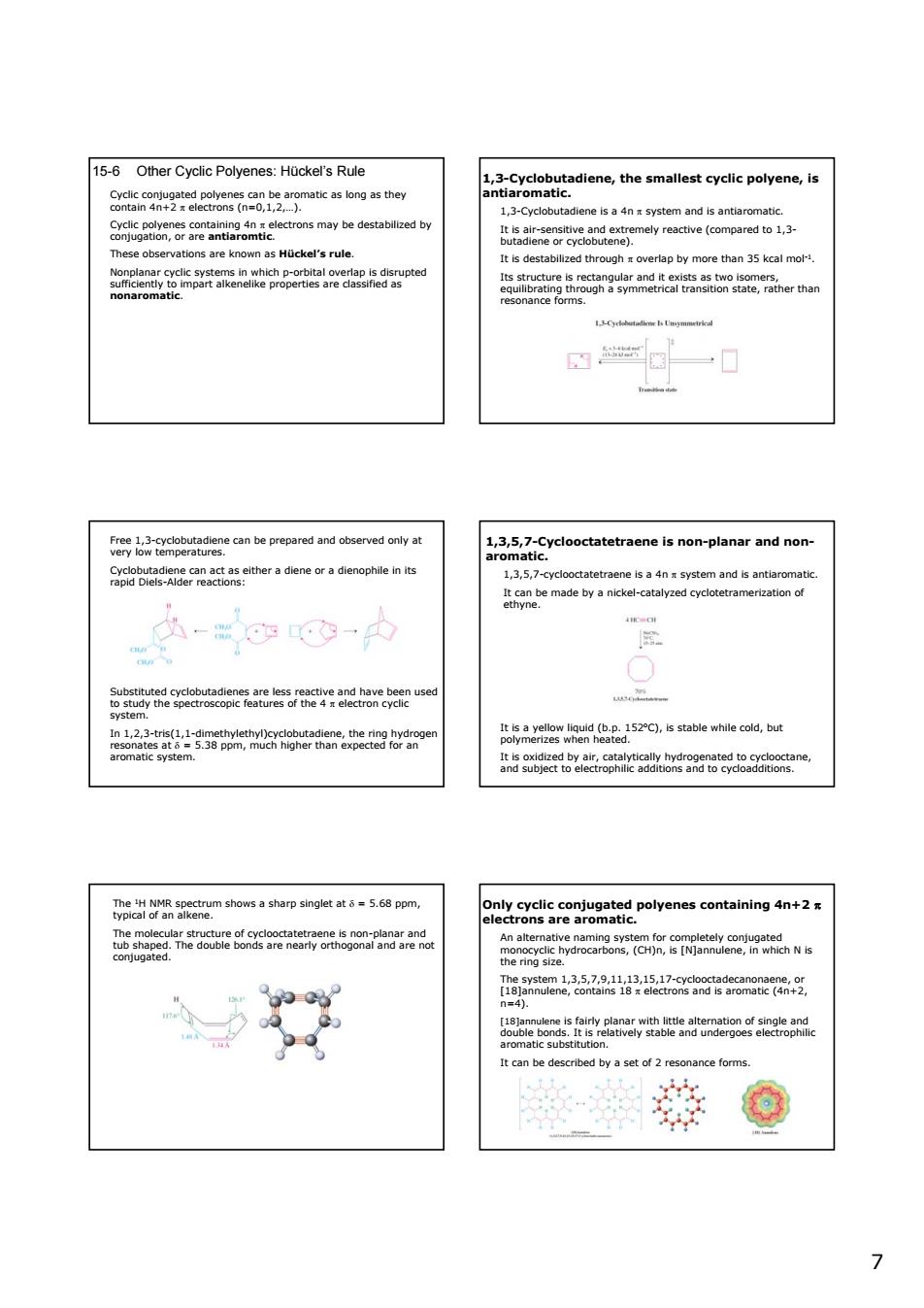正在加载图片...

15-6 Other Cvclic Polvenes:Hockel's Rule 1,Cyclobutadiene,thesmalles cyclicpolyene,is ctrons may be destabilized by These observations are known as Huc el's rule. It is destab zed through x overlap by more than 35 kcal mola 1,3,5,7-Cyclooctatetraene is non-planar and non- econ ither a diene or a dienophile in its 多品oeee 品2 po()stable,but saaa8tic3tacica8rargr8eatre8a3Geoan eegtseaaspotyenescontaning4n+2 oo86g品N。 0生a ya6品。 e described by a set of 2 re ance forms 7 7 15-6 Other Cyclic Polyenes: Hückel’s Rule Cyclic conjugated polyenes can be aromatic as long as they contain 4n+2 π electrons (n=0,1,2,…). Cyclic polyenes containing 4n π electrons may be destabilized by conjugation, or are antiaromtic. These observations are known as Hückel’s rule. Nonplanar cyclic systems in which p-orbital overlap is disrupted sufficiently to impart alkenelike properties are classified as nonaromatic. 1,3-Cyclobutadiene, the smallest cyclic polyene, is antiaromatic. 1,3-Cyclobutadiene is a 4n π system and is antiaromatic. It is air-sensitive and extremely reactive (compared to 1,3- butadiene or cyclobutene). It is destabilized through π overlap by more than 35 kcal mol-1. Its structure is rectangular and it exists as two isomers, equilibrating through a symmetrical transition state, rather than resonance forms. Free 1,3-cyclobutadiene can be prepared and observed only at very low temperatures. Cyclobutadiene can act as either a diene or a dienophile in its rapid Diels-Alder reactions: Substituted cyclobutadienes are less reactive and have been used to study the spectroscopic features of the 4 π electron cyclic system. In 1,2,3-tris(1,1-dimethylethyl)cyclobutadiene, the ring hydrogen resonates at δ = 5.38 ppm, much higher than expected for an aromatic system. 1,3,5,7-Cyclooctatetraene is non-planar and nonaromatic. 1,3,5,7-cyclooctatetraene is a 4n π system and is antiaromatic. It can be made by a nickel-catalyzed cyclotetramerization of ethyne. It is a yellow liquid (b.p. 152oC), is stable while cold, but polymerizes when heated. It is oxidized by air, catalytically hydrogenated to cyclooctane, and subject to electrophilic additions and to cycloadditions. The 1H NMR spectrum shows a sharp singlet at δ = 5.68 ppm, typical of an alkene. The molecular structure of cyclooctatetraene is non-planar and tub shaped. The double bonds are nearly orthogonal and are not conjugated. Only cyclic conjugated polyenes containing 4n+2 π electrons are aromatic. An alternative naming system for completely conjugated monocyclic hydrocarbons, (CH)n, is [N]annulene, in which N is the ring size. The system 1,3,5,7,9,11,13,15,17-cyclooctadecanonaene, or [18]annulene, contains 18 π electrons and is aromatic (4n+2, n=4). [18]annulene is fairly planar with little alternation of single and double bonds. It is relatively stable and undergoes electrophilic aromatic substitution. It can be described by a set of 2 resonance forms